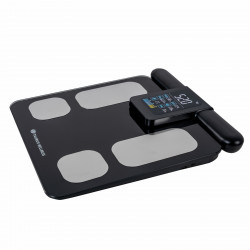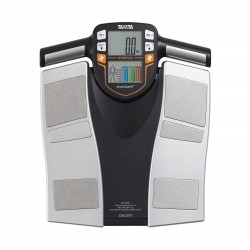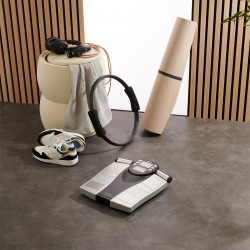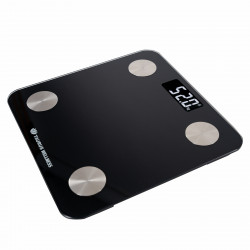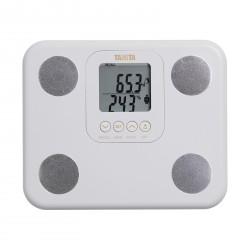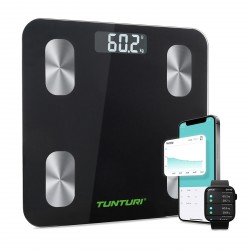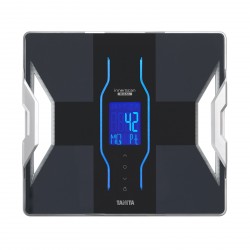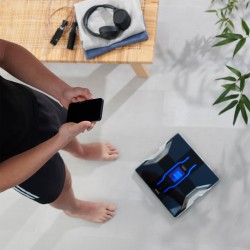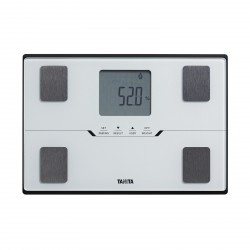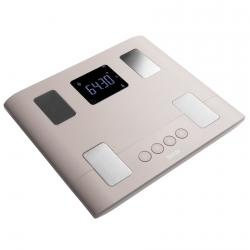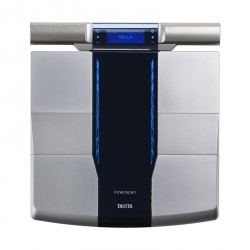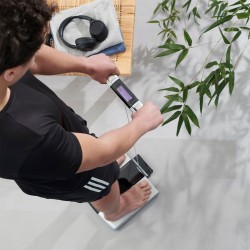Filter
Body Composition Scales
-
BEFORE £99.99TODAY £89.994 interest-free payments of £22.50
-
RRP £210.00 -10%NOW £189.004 interest-free payments of £47.25
-
BEFORE £24.99TODAY £22.494 interest-free payments of £5.62
-
RRP £59.99 -18%NOW £49.004 interest-free payments of £12.25
-
BEFORE £19.99TODAY £17.994 interest-free payments of £4.50
-
RRP £179.00 -11%NOW from £159.004 interest-free payments of £39.75
-
RRP £89.00 -11%NOW from £79.004 interest-free payments of £19.75
-
RRP £139.00 -7%NOW £129.004 interest-free payments of £32.25
-
RRP £455.00 -8%NOW £415.004 interest-free payments of £103.75
Segmental Body Composition Scales Explained

Tracking your weight is one thing, but it rarely tells the full story. If you’ve ever felt frustrated by a number that won’t budge, or confused by changes that don’t seem to make sense, a segmental body composition scale can fill in the gaps.
These monitors show what’s going on in different parts of your body, like how much muscle you’ve built in your legs or how fat levels are shifting around your torso. It’s a simple way to get more useful information, especially if you're following a training plan, changing your routine or just curious about what’s happening beneath the surface.
What Is a Segmental Body Composition Scale?
A segmental body composition scale measures more than just your total body weight. It checks how much fat, muscle and water you have in different areas, like your arms, legs and torso. This gives you a more detailed picture of your body’s makeup.
Instead of treating the body as one single unit, the scale uses multiple contact points, usually through hand and foot electrodes, to send a small electrical signal through the body. The way this signal moves helps the scale work out the composition of each segment.
This is especially useful if you’re tracking changes over time. You might see muscle gain in your legs, a drop in fat around your middle, or even notice imbalances between one side of the body and the other. It’s information you won’t get from a regular scale.
How Do Body Fat Scales Work?

Body fat scales use a method called bioelectrical impedance analysis (BIA). When you step on the scale, a small electrical signal passes through your body. It’s completely painless and nothing you’ll feel, but it tells the scale how easily that signal travels through different types of tissue.
Fat, muscle and water all conduct electricity differently. By measuring the resistance, the scale can estimate the amount of fat, muscle mass and other key stats. Segmental models take this further by using hand and foot sensors to track different areas separately. That’s how you get a breakdown for your arms, legs and torso, rather than just one overall reading.
Common Measurements You’ll See:
Body fat %: How much of your body is made up of fat
Muscle mass: The weight of muscle in your body
Total body water %: The amount of fluid in your body
Visceral fat: Fat stored around your organs
Bone mass: The estimated weight of bone mineral
Metabolic age: A comparison of your BMR to average age groups
Basal metabolic rate (BMR): The number of calories your body burns at rest
Physique rating: A general overview of body composition
Some scales also give segmental readings for left vs right sides, which can help highlight imbalances or track progress more accurately in training.
Muscle mass: The weight of muscle in your body
Total body water %: The amount of fluid in your body
Visceral fat: Fat stored around your organs
Bone mass: The estimated weight of bone mineral
Metabolic age: A comparison of your BMR to average age groups
Basal metabolic rate (BMR): The number of calories your body burns at rest
Physique rating: A general overview of body composition
Some scales also give segmental readings for left vs right sides, which can help highlight imbalances or track progress more accurately in training.
Types of Body Composition Monitors
Body composition monitors come in a few different formats, depending on how much detail you want.
1. Standard Body Composition Scales
These are usually single-point scales you step on. They measure overall stats like body fat, muscle mass and water percentage, but they treat the body as one unit. Useful for general tracking, but less precise than segmental models.
2. Segmental Body Composition Scales
These provide a more detailed breakdown by measuring specific areas like your arms, legs and trunk. They use extra contact points, usually with hand grips and footplates, to collect more data. You’ll see differences between body parts, which can be helpful if you’re training for performance, recovering from injury or watching for imbalances.
3. Handheld Monitors
These are compact devices with handles, often used on their own or alongside other equipment. They measure upper body composition but don’t usually include legs or overall body weight. Handy in some settings, but limited in scope.
4. Medical-Grade Monitors
Used in clinics, hospitals and research, these offer highly accurate readings and often use multi-frequency BIA. They’re more complex (and much pricier) than home-use models, and usually not necessary for everyday tracking.
Benefits of Using One
Knowing your weight might tell you something, but it won’t tell you everything. A body composition monitor adds real detail, showing how fat, muscle and other key measurements are shifting over time. That extra layer of information can be a game changer, especially when you're trying to understand what’s actually working in your routine.
Here are some of the key benefits:
Tracks progress more accurately: You might weigh the same, but your fat and muscle levels could be shifting. A body composition scale picks up those changes that regular scales miss.
Helps with goal setting: Seeing detailed stats like muscle mass or visceral fat can make your targets more specific and realistic.
Highlights imbalances: Segmental models can show if one side of your body is stronger or leaner than the other, which is useful for training, recovery or injury prevention.
Monitors long-term trends: Over time, you can spot patterns and make more informed decisions about exercise, nutrition and recovery.
Adds context to your health data: It’s easier to make sense of changes in energy levels, strength or fitness when you’ve got more than just a weight figure to go by.
Tracks progress more accurately: You might weigh the same, but your fat and muscle levels could be shifting. A body composition scale picks up those changes that regular scales miss.
Helps with goal setting: Seeing detailed stats like muscle mass or visceral fat can make your targets more specific and realistic.
Highlights imbalances: Segmental models can show if one side of your body is stronger or leaner than the other, which is useful for training, recovery or injury prevention.
Monitors long-term trends: Over time, you can spot patterns and make more informed decisions about exercise, nutrition and recovery.
Adds context to your health data: It’s easier to make sense of changes in energy levels, strength or fitness when you’ve got more than just a weight figure to go by.
Body Composition vs Regular Scales
Regular bathroom scales show your total weight. That’s it. They can’t tell if the number has gone up because you’ve gained muscle, retained water or just had a bigger meal the night before.
Body composition monitors take things further by estimating what that weight is made up of. You’ll see breakdowns for fat, muscle, water and sometimes even bone mass. Segmental models go a step beyond that, showing how those values differ across various parts of the body.
So while a standard scale might show no change at all, a body composition monitor can reveal that you’ve lost fat and gained muscle — a big difference that basic scales can’t pick up.
Body composition monitors take things further by estimating what that weight is made up of. You’ll see breakdowns for fat, muscle, water and sometimes even bone mass. Segmental models go a step beyond that, showing how those values differ across various parts of the body.
So while a standard scale might show no change at all, a body composition monitor can reveal that you’ve lost fat and gained muscle — a big difference that basic scales can’t pick up.
How Accurate Are Body Fat Scales Compared to Other Methods?
Body fat scales use bioelectrical impedance analysis (BIA), which gives a reasonably good estimate of your body composition. For home use, it’s one of the most accessible and consistent methods, as long as you use it under similar conditions each time.
That said, it’s not the most precise method out there. More advanced options like DEXA scans or hydrostatic weighing tend to be more accurate, but they also involve specialist equipment, appointments and a much higher cost.
The key with body fat scales is consistency. If you use the same scale regularly, at the same time of day and under similar conditions, you’ll get a clear picture of how things are shifting over time. The exact numbers might vary slightly, but the trends are what really matter.
That said, it’s not the most precise method out there. More advanced options like DEXA scans or hydrostatic weighing tend to be more accurate, but they also involve specialist equipment, appointments and a much higher cost.
The key with body fat scales is consistency. If you use the same scale regularly, at the same time of day and under similar conditions, you’ll get a clear picture of how things are shifting over time. The exact numbers might vary slightly, but the trends are what really matter.
Are They Safe?

For most people, body composition scales are completely safe to use. The electrical signal they send through the body is very low and painless. You won’t feel a thing.
However, there are a few exceptions. If you have a pacemaker or other implanted medical device, it’s best to avoid using any body composition monitor that relies on bioelectrical impedance. The signal is small, but it’s still advised against in those cases. Pregnant people are often advised not to rely on the readings either. The measurements may not be accurate, and it’s best to speak to a healthcare provider if there are any concerns.
If in doubt, check the user manual or get professional advice before using the scale, especially if you have a medical condition or device.
However, there are a few exceptions. If you have a pacemaker or other implanted medical device, it’s best to avoid using any body composition monitor that relies on bioelectrical impedance. The signal is small, but it’s still advised against in those cases. Pregnant people are often advised not to rely on the readings either. The measurements may not be accurate, and it’s best to speak to a healthcare provider if there are any concerns.
If in doubt, check the user manual or get professional advice before using the scale, especially if you have a medical condition or device.
How to Use a Body Composition Monitor Correctly

To get the most out of your body composition scale, it helps to use it in a consistent way. Timing, setup and a few small habits can make the readings more reliable.
When to Use It
Measure at the same time of day, preferably in the morning before eating or drinking. Avoid using it straight after exercise, showering or meals, as these can affect hydration and skew the results.
What to Do
Stand still with bare feet on the sensors. If the scale has hand grips, hold them as shown in the manual, with arms slightly away from your sides. Keep still during the reading and avoid shifting your weight.
How to Read the Results
Focus on patterns over time, not single readings. Day-to-day numbers can vary slightly, but longer-term trends will give you a clearer view of what’s changing in your body.. If your scale links to an app, it can help store and track data automatically. Otherwise, jot it down somewhere consistent so you can compare over weeks or months.
What to Consider Before Buying
Before choosing a body composition scale, think about how detailed you want your results to be, how you plan to track them, and who else might be using the device. Some models offer more in-depth analysis, while others focus on the basics. The best choice depends on your goals and daily routine.
Level of Detail
Basic models give you whole-body stats. Segmental scales provide a breakdown by area — arms, legs, and torso. If you want more insight into specific changes, segmental is the way to go.
User Profiles
Some scales store data for multiple users, which is helpful if more than one person in the household is tracking progress.
App Connectivity
Many smart scales sync with apps to store and chart your results. Check if the app is easy to use and compatible with your phone or smartwatch.
Display and Readability
Look for a clear screen with easy-to-read figures. Backlit displays are useful if you tend to weigh in early mornings or evenings.
Maximum Weight and Platform Size
Make sure the scale suits your weight range and that the platform feels stable underfoot. A wider base can be more comfortable, especially for larger shoe sizes.
Power Source
Some models use AA or AAA batteries. Others are rechargeable. Think about what suits your routine best.
Best Smart Scales of 2025 at Fitshop

TANITA RD-545HR Smart Segmental Body Composition Scale
One of the most advanced options available. Gives you a detailed breakdown of fat and muscle across each limb and your trunk. Ideal if you want full-body insight and you're serious about tracking your training.
Shop →
Shop →

TANITA BC-545N Segmental Body Composition Scale
Simple to use, with easy hand grips and a clear display. Great for seeing how different parts of your body are changing over time, especially if you're focused on strength or recovery.
Shop →
Shop →

TANITA RD-953 Smart Body Composition Scale
A sleek smart scale that connects to the app and tracks a wide range of stats. Good if you want something modern that keeps everything stored in one place.
Shop →
Shop →

TANITA BC-401 Smart Body Composition Scale
Covers the essentials and syncs with the Tanita app for easy progress tracking. Works for multiple users, so it's handy if you're sharing it at home.
Shop →
Shop →

TANITA BC-730 Body Composition Scale
Small in size but covers the basics well. Tracks fat, water and muscle, without any added extras. Good for everyday use when you just want the key stats.
Shop →
Shop →

TANITA BC-333LE Smart Body Composition Scale
Smart and simple, with quick syncing to the Tanita app. Tracks key stats like fat, muscle and water, with a clean display that’s easy to read and navigate.
Shop →
Shop →

Taurus Wellness Body Composition Scale Pro
Tracks a wide range of measurements and feels stable underfoot. A practical choice for busy households or anyone who checks in regularly.
Shop →
Shop →

Taurus Wellness Body Composition Scale
Tracks fat, water and muscle with a simple setup. A good match if you just want to check your fat, water and muscle levels without the tech extras.
Shop →
Shop →

Tunturi SC30 Smart Scale
Clean display, app-friendly and easy to get started with. Tracks core stats like fat and muscle, and keeps things simple to use day to day.
Shop →
Shop →
Why Buy Your Body Composition Scales From Fitshop?
Fitshop is the longest-established fitness equipment retailer in the UK and Europe’s #1 for home fitness. When you choose to buy from us, you’ll enjoy a range of great benefits, including:
- Expert sales staff offering impartial advice in-store, online, over the phone, via email, live chat, and social media.
- Try before you buy: Most of our Body Composition Scales and equipment can be tested in-store, and we offer demos of compatible workout apps. Find your nearest store here.
- Interest-free finance: Available both online and in-store to help you invest in your purchase. Find out more here.
- Delivery: We offer various delivery options across the UK through our trusted courier partners. Learn more here.
- Aftercare: Our dedicated team provides world-class support and is available 7 days a week to help with any questions or queries.
SALES TEAM
If you’d like to learn more about our range of Body Composition Scales or have any other questions, don’t hesitate to contact our in-house commercial sales team at sales@fitshop.co.uk or call us on 0141 737 2250.


